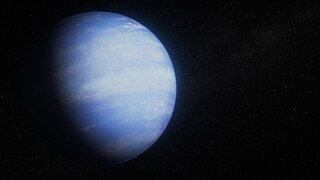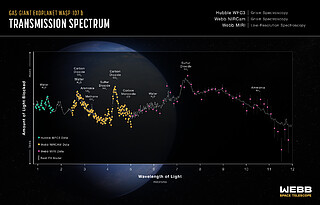weic2414 — Science Release
Webb cracks case of inflated exoplanet
20 May 2024
Data collected using the NASA/ESA/CSA James Webb Space Telescope, combined with earlier observations from the NASA/ESA Hubble Space Telescope, show surprisingly little methane (CH4) in the atmosphere of WASP-107 b, indicating that the interior of the planet must be significantly hotter and the core much more massive than previously estimated.
Why is the warm gas-giant exoplanet WASP-107 b so puffy? Two independent teams of researchers have an answer.
The unexpectedly high temperature is thought to be a result of tidal heating caused by the planet’s slightly non-circular orbit, and can explain how WASP-107 b can be so inflated without resorting to extreme theories of how it formed.
The results, which were made possible by Webb’s extraordinary ability to measure light passing through exoplanet atmospheres, may explain the puffiness of dozens of low-density exoplanets, helping to solve a long-standing mystery in exoplanet science.
The problem with WASP-107 b
At more than three-quarters the volume of Jupiter but less than one-tenth the mass, the ‘warm Neptune’ exoplanet WASP-107 b is one of the least dense planets known. While puffy planets are not uncommon, most are hotter and more massive, and therefore easier to explain.
“Based on its radius, mass, and age , we thought WASP-107 b had a very small, rocky core surrounded by a huge mass of hydrogen and helium,” explained Luis Welbanks from Arizona State University (ASU), lead author of a paper published today in Nature. “But it was hard to understand how such a small core could sweep up so much gas, and then stop short of growing fully into a Jupiter-mass planet.”
If WASP-107 b instead has more of its mass in the core, the atmosphere should have contracted as the planet cooled in the time since it formed. Without a source of heat to re-expand the gas, the planet should be much smaller. Although WASP-107 b has an orbital distance of just 5 million miles (one-seventh of the distance between Mercury and the Sun), it doesn’t receive enough energy from its star to be so inflated.
“WASP-107 b is such an interesting target for Webb because it’s significantly cooler and more Neptune-like in mass than many of the other low-density planets, the hot Jupiters, we’ve been studying,” said David Sing from the Johns Hopkins University (JHU), lead author of a parallel study also published today in Nature. “As a result, we should be able to detect methane and other molecules that can give us information about its chemistry and internal dynamics that we can’t get from a hotter planet.”
A wealth of previously undetectable molecules
WASP-107 b’s giant radius, extended atmosphere, and edge-on orbit make it ideal for transmission spectroscopy, a method used to identify the various gases in an exoplanet atmosphere based on how they affect starlight.
Combining observations from Webb’s NIRCam (Near-Infrared Camera) and MIRI (Mid-Infrared Instrument), and Hubble’s WFC3 (Wide Field Camera 3), Welbanks’s team was able to build a broad spectrum of 0.8- to 12.2-micron light absorbed by WASP-107 b’s atmosphere. Using Webb’s NIRSpec (Near-Infrared Spectrograph), Sing’s team built an independent spectrum covering 2.7 to 5.2 microns .
The remarkable precision of the data makes it possible to not just detect, but actually measure the abundances of a wealth of molecules, including water vapour (H2O), methane (CH4), carbon dioxide (CO2), carbon monoxide (CO), sulphur dioxide (SO2), and ammonia (NH3).
“With Webb’s NIRSpec spectroscopy we get direct insights into the chemistry of WASP-107 b”, said Stephan Birkmann of the European Space Agency and the Principal Investigator of the study’s NIRSpec observations. “The NIRSpec spectroscopy lets us probe the atmospheric composition of the planet, and neatly complements the MIRI and NIRCam observations.”
Roiling gas, hot Interior, and massive core
Both spectra show a surprising lack of methane in WASP-107 b’s atmosphere: one-thousandth of the amount expected based on its assumed temperature.
“This is evidence that hot gas from deep in the planet must be mixing vigorously with the cooler layers higher up,” explained Sing. “Methane is unstable at high temperatures. The fact that we detected so little, even though we did detect other carbon-bearing molecules, tells us that the interior of the planet must be significantly hotter than we thought.”
A likely source of WASP-107 b’s extra internal energy is tidal heating caused by its slightly elliptical orbit. With the distance between the star and planet changing continuously over the 5.7-day orbit, the gravitational pull is also changing, stretching the planet and heating it up.
Researchers had previously proposed that tidal heating could be the cause of WASP-107 b’s puffiness, but until the Webb results were in, there was no evidence.
Once they established that the planet has enough internal heat to thoroughly churn up the atmosphere, the teams realised that the spectra could also provide a new way to estimate the size of the core.
“If we know how much energy is in the planet, and we know what proportion of the planet is heavier elements like carbon, nitrogen, oxygen, and sulphur, versus how much is hydrogen and helium, we can calculate how much mass must be in the core,” explained Daniel Thorngren from JHU.
It turns out that the core is at least twice as massive as originally estimated, which makes more sense in terms of how planets form.
Altogether, it turns out that WASP-107 b is not as mysterious as it once appeared.
“The Webb data tell us that planets like WASP-107 b didn’t have to form in some odd way with a super-small core and a huge gassy envelope,” explained Mike Line from ASU. “Instead, we can take something more like Neptune, with a lot of rock and not as much gas, just dial up the temperature, and poof it up to look the way it does.”
More information
Webb is the largest, most powerful telescope ever launched into space. Under an international collaboration agreement, ESA provided the telescope’s launch service, using the Ariane 5 launch vehicle. Working with partners, ESA was responsible for the development and qualification of Ariane 5 adaptations for the Webb mission and for the procurement of the launch service by Arianespace. ESA also provided the workhorse spectrograph NIRSpec and 50% of the mid-infrared instrument MIRI, which was designed and built by a consortium of nationally funded European Institutes (The MIRI European Consortium) in partnership with JPL and the University of Arizona.
Webb is an international partnership between NASA, ESA and the Canadian Space Agency (CSA).
Image Credit: NASA, ESA, CSA, R. Crawford (STScI)
Links
- Science paper (L. Welbanks, et al.)
- Science paper (D. Sing, et al.)
- Science paper (A. Dyrek, et al.)
- Release on STScI website
Contacts
Bethany Downer
ESA/Webb Chief Science Communications Officer
Email: [email protected]
Ninja Menning
ESA Newsroom and Media Relations Office
Email: [email protected]
About the Release
| Release No.: | weic2414 | |
|---|---|---|





